
OTHER TOP RATED ARTICLES: FARANG CYCLE OF LIFE AND DEATH IN THAILAND
BEST PRACTICAL TIPS FOR DRIVING SAFELY IN THAILAND
CONTENTS
I. Why is it important to prepare for Thai traffic situations?
II. How is Thai traffic different?
III. Thai authorities' response to Thai traffic behaviour
IV. How and why do most accidents happen in Thailand?
V. How to stay safe?
Traffic rules in theory apply internationally and so also in Thailand, but traffic behaviour in Thailand is rather different mainly because of cultural and development factors. Thai people tend to bend (or break) the rules, so in daily practice traffic rules aren’t observed in the same way as in more developed countries and if you want to stay safe, you’d better be aware of how things are different here.
This is all the more important because Thailand is year-and-again amongst the top countries of having traffic accidents in the world (!).
What makes Thai traffic behaviour different from what you're used to in your own country has everything to do with how Thai culture1 and the way the country is organised. In this article, I am going to show you how certain features of Thai culture affect actual traffic behaviour, but you can also use this article reversely: by understanding Thai-style traffic you can actually understand more about how Thai people think.
Chain collision shows what can happen on Thai roads and highways: no less than 8 cars and 1 motorcycle were involved in the collision.
There are reasons why accidents happen more in Thailand than almost anywhere else in the world.
Thailand has for many years in a row ranked amongst the top countries of having traffic accidents in the world, especially for motorcyle accidents, according to studies from the WHO.
The Thai authorities also monitor the number of traffic accidents and fatalities, especially in the so-called Seven Dangerous Days of the Year, which is the period around Western New Year, and the period around Thai New Year Songkran. Every year, tens of people die per day during these dangerous periods and hundreds are injured, with Chiang Mai as one of the most dangerous provinces in the entire country.
Many foreigners are involved in traffic accidents in Thailand, for the simple reason that they trusted international rules and were not accustomed to the ways in which Thai people drive.
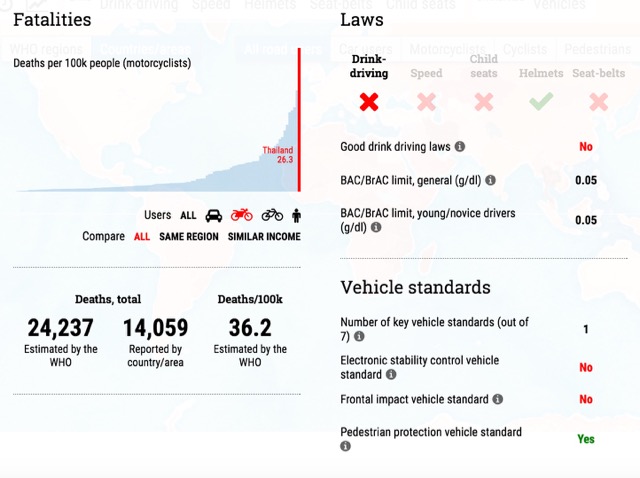
Thailand ranks amongst the top of the world for traffic accidents, especially motorcycle accidents. Source: WHO.
The most important factor that influences all Thai traffic behaviour is what I call a Thai driver’s ‘Range of Responsibility’. A Thai driver’s Range of Responsibility is what he2 (should) pay attention to in Thai-style, basically it's all that appears in his eyesight without turning his head, so we’re talking about an angle of roughly 90-140 degrees in front of the vehicle.
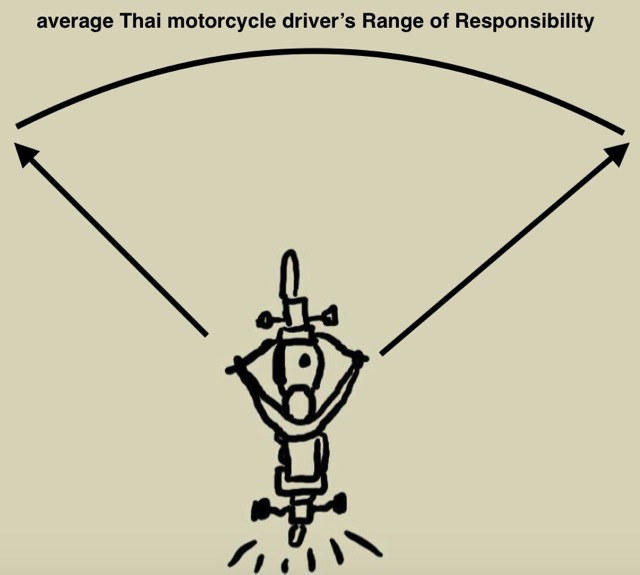
The average Thai driver's span of attention is only in front of him without turning his head.
This is implicitly understood to be his Range of Responsibility.
So, while an international driver's Range of Responsibility is 360 degrees, the Thai driver's practical Range or Responsibility is at most about half of that.
According to international traffic rules, you have to check your mirrors and do a shoulder check when you change lanes, make a turn or in other circumstances, but because Thai people are inherently lazy, most of them fail to do that consistently. And because most Thai people don’t make sufficient use of mirrors and shoulder check, there is an implicit collective understanding that a driver’s main (or even only) responsibility rests within the span of his eyesight in front of him, his Range of Responsibility.
To put it simple, everyone basically cares (mostly) about what is in front and as far as the corners of the eyes can see, almost without turning a head.
Does that work? Well, it works in many cases and in a way it could be an efficient way to deal with traffic but the one disadvantage this lazy system has is that it doesn’t sufficiently cover the so-called blind angle (or blind spot) that is located somewhere behind you and at your sides, so this becomes a grey area between the driver in front and the one in the blind angle and thus creates a risk for accidents to happen.
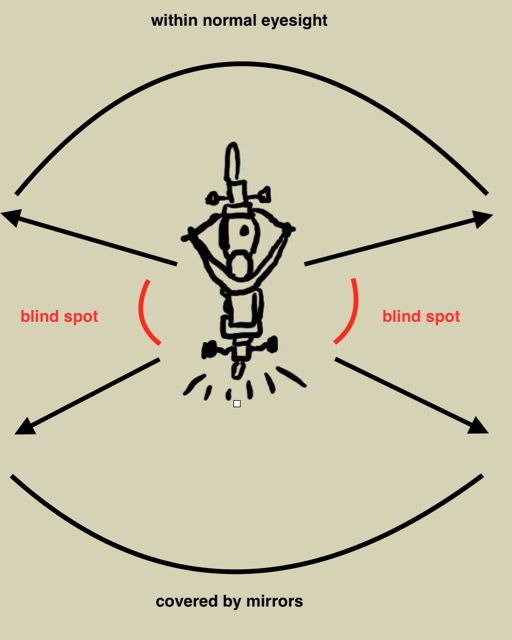
Because most Thai drivers neglect a shoulder check (and many also forget to check mirrors),
there are often huge areas uncovered by their attention, especially the blind angles / blind spots.
BECAUSE THE RANGE OF RESPONSIBILITY IS THAI TRAFFIC'S MAIN "RULE"
IT INFLUENCES ALL, GOOD AND BAD
Because of the Range of Responsibility is a Thai driver's implicit leading principle, everything else depends on it. It almost doesn't matter who's right or wrong according to the official rules, in practice everyone acts according to this principle.
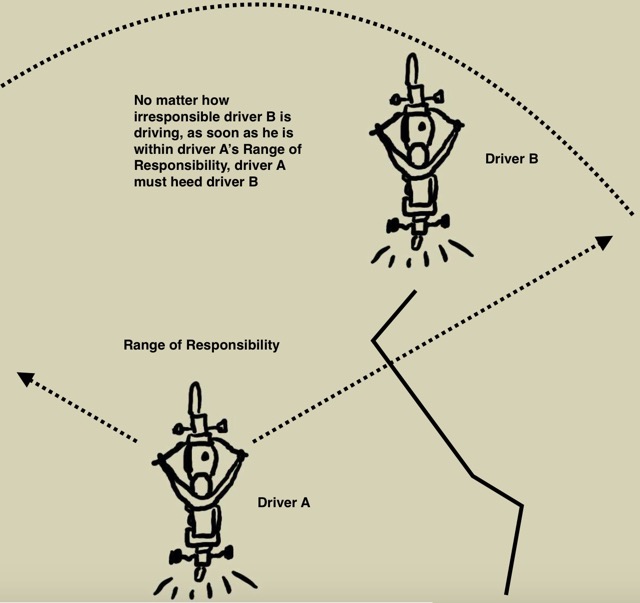
No matter how irresponsible driver B drives, he is within driver A's Range of Responsibility
so it's driver A that should heed driver B, according to Thai traffic "rules".
For example, you could make signs that you want to move sideways from one lane to another or make strange movements and you'll find, to your surprise perhaps, that someone behind you is waiting for you to cross lanes, even though according to international rules you were supposed to wait for the person behind to pass you first or even though you are acting wrongly according to the real rules.
"You're in my sight so I adapt to you" is the practical solution that Thai traffic society has adopted.
Another example is that Thai drivers tend to overtake someone just before a turn, which in international context doesn’t make sense, creates dangerous situations and also obstructs the flow of traffic, but it does make sense in Thai context because when driver B suddenly appears in front of driver A, it means that now driver A has to take driver B into account because B is in A’s Range of Responsibility.
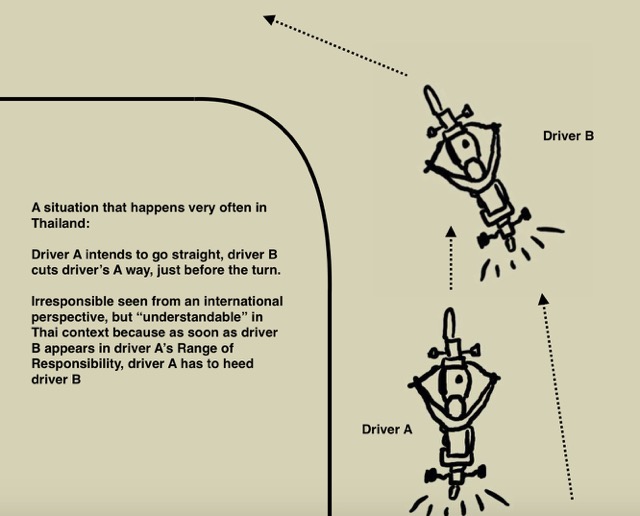
Cutting someone else's way is very common in Thailand. It's irresponsible from international perspective but "understandable" in Thai context because as soon as you appear in someone else's Range of Responsibility, he should heed you, even if you drive irresponsibly.
I believe that even the Thai police and Thai insurance companies make (implicit or explicit) assessments based on a driver’s Range of Responsibility, so that some accidents are blamed on the person behind while in an international context that person would have been right.
So the Range of Responsibility is really important and it actually conflicts with international traffic rules as you’re probably used to.
Another important implicit feature of Thai traffic behaviour which has everything to do with Thai culture is that Thai drivers continuously adapt to each other rather than rely on real traffic rules. In other words, it’s more important to watch and adapt than to trust and follow the rules.
This collective implicit understanding in Thai traffic actually made me fail my Hong Kong motorcycle driving test, because I picked up this Thai habit of stopping or moving very slowly when the traffic situation appears unclear, while in international context you are supposed to rely on other drivers acting according to the rules and keep your speed.
Adapting to each other continuously is a typical Asian cultural feature that can be witnessed to its maximum in Vietnamese traffic, that consists of rivers of scooters flowing down the streets like a school of fish. Japanese people show adaptive yet at the same time extreme law-abiding behaviour, but like other Asians are also a group-oriented people where the harmony of the group are more important than the rights of an individual.
In stark contrast to that, Western people tend to be more strict and rely on rules while insisting on their individual rights, so here are some fundamental differences which clearly play out even in traffic situations.
Thai people aren't exactly amongst the most law-abiding people in the world, rules are publicly acknowledged but are often easily bent in public or broken in secret. In a similar way that many Thai treat a promise as being a mere intention that can be put aside using any (lame) excuse, rules, laws and regulations are often treated merely as guidelines that can be deviated from when you need to.
NOTHING REALLY MATTERS
EVERYTHING IS EMBRACED BY THE ALL-ABSOLVING MANTRA
THAT VIBRATES THROUGH THAI SOCIETY:
MAI-PEN-RAI SABAI-SABAI
In traffic, you can witness that in more cases than I can describe: parking right at corners (with red-and-white pavement signs), driving against the traffic flow, driving without lights on and so on. It all doesn't matter, it's is warmly embraced by the all-encompassing, all-absolving mantra that vibrates through Thai society: mai-pen-rai, sabai-sabai. Even by law enforcers.
For example, at intersections without traffic lights typically you can observe that normal traffic rules don't apply: traffic from the left is supposed to have priority, but in practice people just watch each others behaviour and the one who pushes on first often goes first. It is a constant give and take (sometimes more take than give), but in a more or less adaptive organic group process, rather than a strict demanding and judging based on rules.
Thai people don’t trust the rules, don’t rely on laws, and don’t trust each other, but instead they are flexible to the situation and adapt.
In Western driving schools you should have learned that you have to do what you can to avoid interrupting the flow of traffic, so you wait until cars pass before you park or get out of a parking space, you don’t stop at the side of the road when that will block the entire lane, you don’t drive slowly where you can drive a decent speed and you make turns quick enough. Much of this is nearly alien to Thai style traffic where the concept of avoiding hindrance to others is nearly absent. This is especially so for tuk tuk and red pick up trucks, which behave like a mafia anyway, but also for other uneducated road users.
Driving 20km per hour, making extremely slow turns, temporarily parking the vehicle in the middle the road thus blocking all traffic behind are all very common in Thailand.
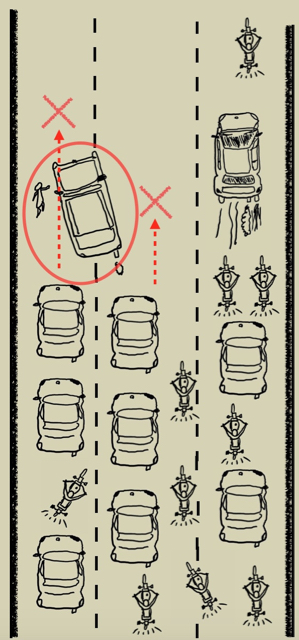
Common causes of traffic congestions on the road are wrong parking and stopping by songtaews to pick up customers.
This songtaew stops diagonally, thus blocking 2 out of 3 lanes.
This again is for a large part due to cultural factors: time isn’t as valuable as in Western societies, there is less of a hurry, there is no concept of opportunity costs, and you’re supposed to adapt and accomodate each other rather than claiming your rights.
You probably have learnt before how to await traffic on a main road to pass first and then make a proper turn into that road, so you want to expect the same from your fellow road users, but in Thailand it's different.
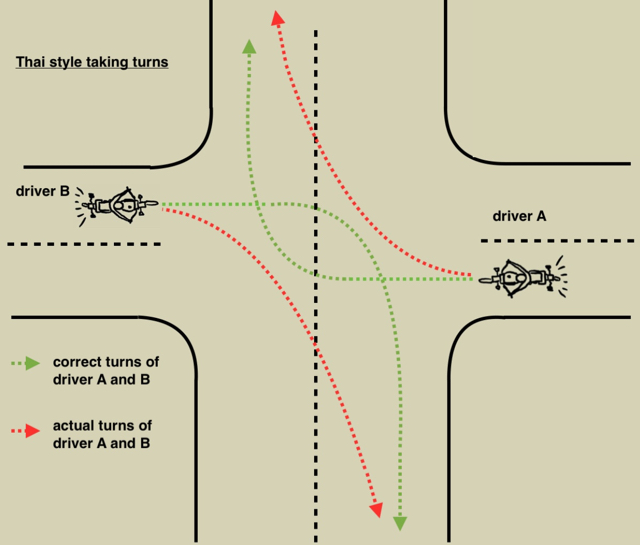
Correct turns of two opposed drivers would be to cross each other, but Thai-style taking turns is likely to avoid that and cut corners. There are underlying cultural factors explaining this preference: whenever Thai people can, they try to avoid conflict and direct confrontation. Also, it's considered 'easier' by Thai drivers to avoid each other than to cross each other and take rules and behaviour into account.
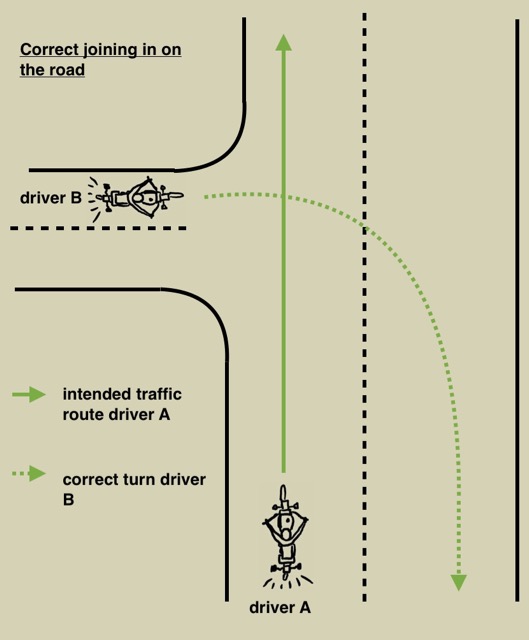
Correct traffic behaviour: driver B should wait for driver A to pass before turning into a main road.
Thai drivers like to cut corners wherever they can, not just in traffic but also in work and study, so you have to anticipate incorrect traffic behaviour like this:
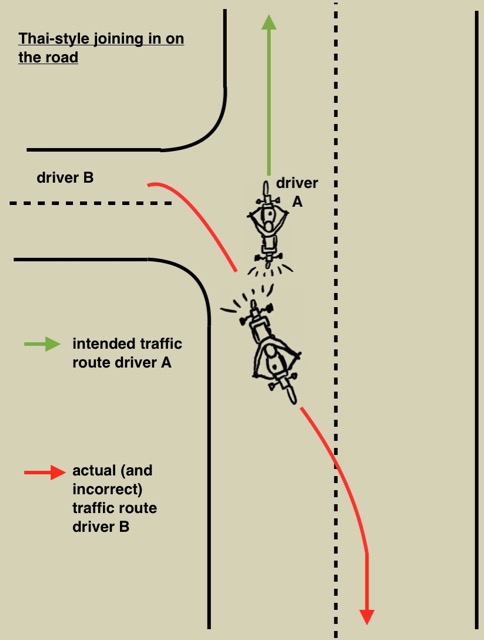
Actual and incorrect Thai-style traffic behaviour: driver B hardly waits for driver A to pass, but instead cuts a big piece of the corner, thereby even driving against the traffic flow and then curve into the main road.
When you're driver A and you see someone trying to join the main road like this, at first you might think the other driver is going to crash into you, and there is a risk to that, but all you have to do is to maintain your speed and be predicable because driver B is making his calculations to join in based on predictable traffic behaviour of other road users.
CUTTING CORNERS IS THE CORNERSTONE OF THE THAI SKILLSET
AND INGRAINED IN THE WAY THAI PEOPLE DO THINGS
Cutting corners is a habit (or skill!) that Thai people have not only in traffic, but in many other aspects of life too: work, social life, study, language. The focus is not on doing things the correct way, but on getting your things done the easier way. That there are consequences, risks and disadvantages to doing things not in the right way is not something most Thai people worry about, as long as you can get away with it now it's good enough.
I've been working with Thai workers for years, even when fixing a leaking water pipe workers prefer to go the quick-and-dirty way taping things away or 'solving' it with lots of silicon, which does the job for a few months, but you know it's not going to last.
Cutting corners is the cornerstone of the Thai skillset and engrained in the way Thai do things.
While Thai people are generally very polite when meeting one-on-one, so in private individual contacts, they can be rather rude when faced anonymously in traffic. Selfishness is the norm, gentleman behaviour is nearly non-existent, flashing lights don't mean allowing another to go first but are meant as a warning that the driver is passing at a high speed and you'd better stay clear.
Lack of signalling or too late signalling before making a turn is another example of selfish behaviour.
Thai culture teaches to be ‘kreng jai’ (เกรงใจ) to each other when the other party is known, but people like to take advantage of each other when unknown.
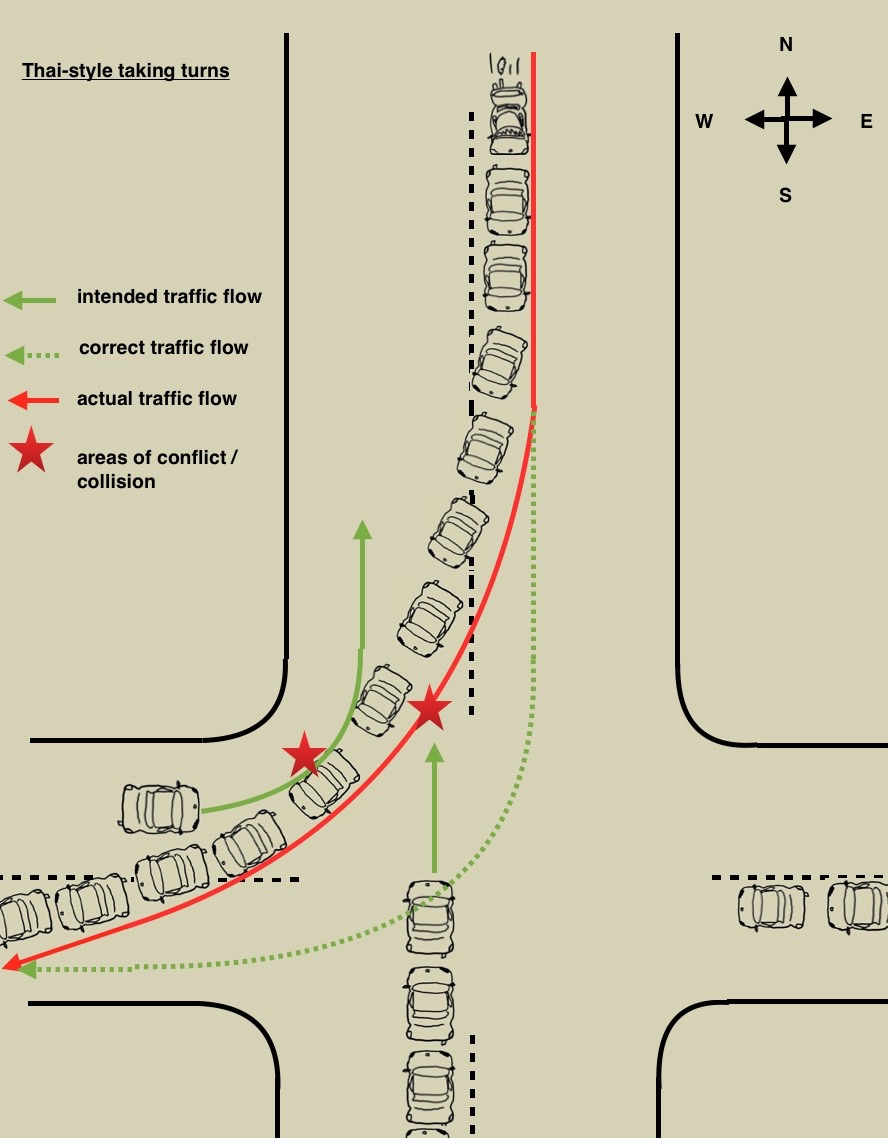
How Thai drivers take turns: each car in line coming from the north and wanting to turn to the west is supposed to wait for the traffic flow coming from the south. Instead, a column of vehicles starts to form that deviates from the proper turn and thus blocks both the traffic coming from the south and the traffic coming from the west. Every single car from the north making the turn before letting the traffic from the south go first is wrong, but in Thailand this is common.
Another way to understand this behaviour is to realize that it is the flow that goes before the rule: once one car making a turn has blocked the normal traffic going straight, quickly other cars behind it join the flow that isn't broking by normal traffic, even though this flow actually breakes the rule.
Many Thai people behave rather selfish in traffic in various ways: when queuing in a jam, many won't give space for incoming traffic waiting to join the main road (rather: they may speed up not to leave a gap and let you go first). When making turns, they just put their vehicle in the middle of the road to block traffic (and actually at times that is the only way to move onto a main road).
The Thai traffic 'rule' that prevails here is: whoever blocks the road goes first.
Now when you're in Thailand for a while, you may get used to this practise of blocking the road and going first, in fact you may find yourself doing it. But when you're blocking someone else on an intersection, and then curse him for not giving you way, while even thinking that he's wrong and you're right, then you know that you've been in Thailand for too long (I realized that recently about myself!).
Not all, but many Thai drive recklessly, with comtempt for danger and near complete disregard for consequences and the (social) environment.
Parents on a scooter with an infant in between their legs on the scooter crawling with feet nearly touch the ground, reckless speeding, drunk driving, dangerous taking over moves, etc. are all very common.
When traffic gets jammed, some vehicles get tempted to overtake the entire queue by crossing over onto the other lane on the inside of a multilane road, so by going against the traffic direction (in Thai: ย้อนทาง or ขับรถย้อนทาง or more commonly ย้อนศร or ขับรถย้อนศร = driving against the traffic flow / arrows). You can see this happening especially during the busy hours, when someone is in a hurry, or when someone wants to skip the entire queue using the lane of opposite direction to join it again at the intersection when the light turns green.
Even a double line in between the opposing lanes which explicitly prohibits crossing it to take over does not stop Thai drivers from doing this (the difference between a single line and a double line in between the lanes of opposing direction is probably hardly noticed).
Taking over using the lane with opposing direction can surprise other road users who did not expect this.
IF YOU ARE WONDERING WHY THAI DRIVERS DRIVE RECKLESSLY
REALIZE THAT YOUR LIFE TO YOU IS PERHAPS MORE PRECIOUS THAN THEIR LIVES TO THEM
Reasons why Thai people drive reckless vary from simple foolishness to carelessness, not bothering about any consequences, which are typically Thai anyway, but some deeper factors are rooted in Buddhism, which in many societies has created not only a peaceful, tolerant and assimilative atmosphere, but wich has also instilled a sense of fatalism, complacency and a kind of passive acceptance of your role in the world into the people. This way, certain ideas can dwell into the Buddhist mindset that take away hope or motivation to change or control your life: 'I was born poor so I remain poor', 'I'll die when it's my time, I can't do anything about it anyway', etc.
Karma is the spiritual Buddhist spinning wheel that will bring to you in your life what you deserve, and although there is controversy over what it actually means, one side of interpretations removes the power of the initiative and the act of taking responsibility.
The Buddhist concept of passing through a sequence of lives can also lead Thai people to see less value and uniqueness in this single life that Christians tend to take so seriously.
All these concepts have over time ingrained themselves deeply into the collective mindset of many Buddhist societies and thus have become a silent root factor in the way people live.
Accidents happen, the cycle of life goes on.
Example of reckless driving on the highway
Because the implementation of rules has (to some extent) been left unclear and is not well enforced, and because most people don't stick to the official rules, grey areas in conduct are created and there is a lack of consensus about what is proper traffic behaviour.
One striking example of that concerns pedestrians crossing the road using a zebra which is sometimes marked by traffic lights. When such crossing is on a main road without an intersection, most Thai drivers are simply not used to the idea of stopping as there aren't pedestrians crossing over all the time. So they may simply keep driving even through a red light.
This creates dangerous situations for foreigners who trust the green light, I've witnessed several near-accidents and one real accident happening like that.
The most dangerous situation happens on a two-lane road (going in the same direction) when one car stops for a pedestrian and the traffic coming from behind on the same land or the adjacent lane didn't realize that fast enough or didn't see the pedestrian. You can see very sad accidents happening in the following clip.
Crossing a main road as a pedestrian can be a very dangerous enterprise in Thailand.
Believe it or not, but Thailand's hit-and-run accidents are infamous. Sadly, many Thai drivers who caused a traffic accident try to flee the scene anonymously as soon as possible. Worse, in some cases they have even tried to kill the already injured victim so as to leave no witness and no claimant alive.
The reason for this is because such persons probably don't have the right insurances to cover a third-party accident and to pay for medical fees and compensations of the victim being handicapped.
Don't be surprised if you're hit in an accident and the other party involved just hands you your helmet, then takes off. You're probably already in a shock that you had an accident, so you may not have the clarity of mind to analyze what just happened and to print the license plate of the other party into your mind.
I can tell you what to do in case of an accident, but better make sure you're simply never involved in any.
The road has a different meaning in Thailand than in say a typical Western-European country. To Thai people, the road used to be the common way to get yourself from A to B for everybody. Have a look at some old pictures of Taphae road in Chiang Mai and you'll see people walking with wagons, buffalos and in the past elephants too. Slow and fast, young and old, wheeled or barefooted, all used to transport themselves on the same dirtroad without any real rules other than just looking around and giving way to traffic that seems to come in front of you and taking the space to move when you can.
Shops and houses would broom the dirt out and dust it all on the common road.
That mentality hasn't changed much. The road is simply for everyone, so the entire concept of separating traffic by type for different types of road is actually alien to Thai custom.
The concept of highways was alledgedly developed by Germany in the worldwars of the previous century to allow tanks to move quickly from one spot to another, an important element of the so-called Blitzkrieg. Highways in the West are truly highways only accessible for traffic that can go at a minimum speed, but on the so-called Superhighway in Chiang Mai you find everything, from cars, agricultural trucks, scooters with less than 200 CC, even pushbikes and riding food hawkers, hey even people walking trying to sell you flowers or what be.
Again, this is a difference between Western culture and Thai culture. Western culture has become more analytical, and developed through distinction of matters, created rules, and people abide by those rules, almost more than they would adapt to a particular situation. In Thai culture, everything goes, there isn't a sharp sense for distinction, the rule is less important than the situation of watching each other, what the other does and adapting to or taking advantage of it.
So on Thai road, you find so many different vehicles, with different speed and traffic behaviour, that often the road just gets clogged up. While in the West, highways generally work because everybody drives the same speed, there are proper bicycle lanes, pedestrian zones, even areas designated for elderly or handicapped people.
In the West, we have developed through separation, in Thailand, everything is mixed together and you got to sort it out by watching your neighbour rather than by remembering a rule.
At first sight, roads in Thailand look pretty normal and good enough, but if you take closer look, the condition of the road actually reflects the state of society. It took me a few years to notice, but once you know, it's actually quite telling.
Have you ever noticed that some of the sewage pits on the road are very deep? Some are located 10cm below the surface of the road. If you don't notice at night or because you're focusing on the traffic around you - trusting the road - your shock breakers could take a big hit and so could you, you could be thrown off your vehicle or loose some control over your gear, especially if you were driving fast.
I kept wondering why they wouldn't level the lid of the pit with the road, and finally I realized why: it's because every few years, the road 'repair' department keeps dumping another layer of asphalt over the road, without bothering about the fundament. Quite often, they wouldn't even bother to fill up some holes first, so eventually the new asphalt layer would sink into those holes and the road will get bumpy again.
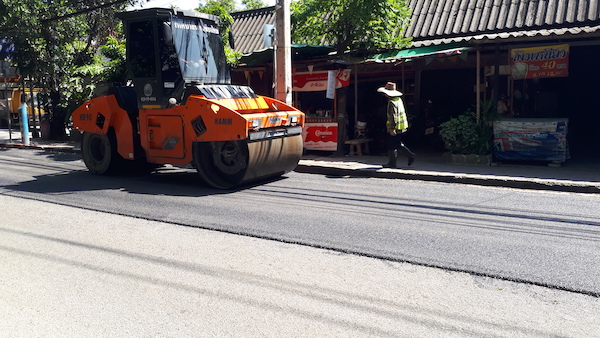
Another layer of asphalt is the Thai quick fix. Note that the pavement has almost been reached.
This is reflective of Thai society: in essence, there is no solid base, things are being quick-fixed as they go and everything looks nice and shiny for a while but from one problem follows another one. The many layers of asphalt are getting so high that the lid of the pit which was originally level with the road now has 'sunk' 10cm. If you carefully inspect the sides of the new asphalt layer, you'll notice how unfinished it actually looks and often the drainage gaps in the side of the pavement also get narrower and narrower because of all these layers of asphalt.
In more developed countries, they would even take out the old layer before putting on a new one, but most importantly, the authories would have invested in a proper and sold foundation of the road that has several components so as to last long and stay even. Not so in Thailand.
When you drive a little bit out of town, you can notice another thing, which is that the main road actually looks okay, but many of side roads and areas in front of shops that feed to the main road are not: they are dirt roads with sand or gravel and the problem of that is that all that sand and gravel ends up on the main road, reducing again the efficiency of the main road because now you can't safely use the shoulders of the road, risking slipping or sliding when you drive fast and need to make a turn or a quick stop.
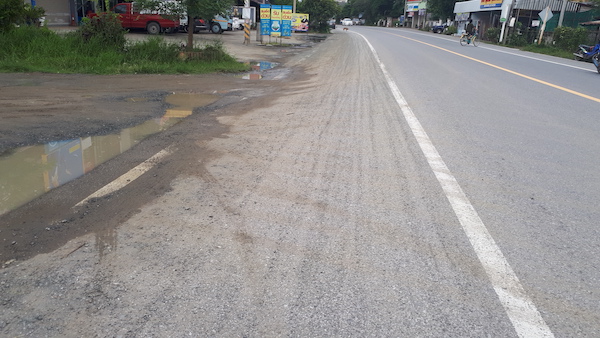
Sand and gravel from dirt at the side of the road makes main roads less efficient and more dangerous
Besides that, roads in Thailand are far more dirty than roads in the West. This is mainly due to use of less clean fuels, that sedimentate on the surface like a black and slippery coating. How dirty the roads are you can see if you walk around town on slippers: your feet will be black by the end of the day. Especially after a light shower of rain, this creates an extremely slippery road condition, so after rain you got to be extra careful when taking turns. Don't lean too much into the curve.
Finally, there can be all sorts of trash on the road, people just wipe dust and rubbish and dirty water out of their houses onto the road instead of disposing of it properly and being really social to others.
So the lack of will to invest in a proper foundation makes the system less efficient, more dangerous and fragile, with a need to 'maintain and repair' it constantly. Isn't that the same for Thai politics, Thai education, business and law? It's simply the type of stuff that makes developing countries developing countries, with a twist for what is uniquely Thai.
Although you should not forget international traffic rules, in order to stay safe you have to adapt to the local situation and you will soon find that a lot of proper international traffic rules almost don't apply or can even bring about more risks in Thai-style traffic.
For example:
These are a few of the most remarkable features of Thai-style traffic that are probably different from what you’re used to. Besides that, almost everything you can imagine could go wrong goes wrong.
Realising that will help you not only to understand more about Thai culture, it can also keep you safer.
Thailand has adopted international traffic rules, but Thai authorities of course have come to realize that not all international rules go very well with Thai culture and traffic behaviour, so they have made alterations aiming at improving traffic situations in a way which is more suitable to Thai drivers.
Unfortunately, not all of them work well.
The many U-turns you find on main roads are an example of that: they are an alternative to having an real intersection. Real intersections in Thailand suffer from the problem that Thai drivers tend to speed up last-minute to push through the last seconds of the green light or the beginning of the red light, thus delaying the traffic coming from the next green light. Also, sometimes traffic doesn't flow through and just parks in the middle of the intersection.
Energetically, intersections embody direct confrontation and demand either complying with the rules or making decisions, all of which don't go that well with Thai culture.
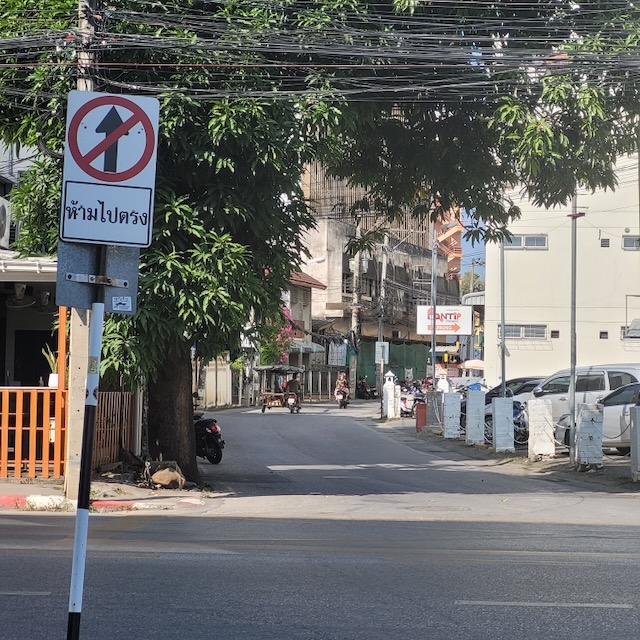
Traffic sign showing the words ห้ามไปตรง 'prohibited to go straight'.
Simply going straight isn't something that goes well with Thai culture and Thai traffic
The U-turn is Thailand's response to that, it allows traffic to gently blend in with the current flow, in other words: it is the Thai alternative to let people interact more harmoniously and it is much more suitable to Thai culture than open or guarded intersections.
In most cases, it actually works. But it can get irritating if you have to drive a few kilometers before you can change direction.
For this reason, I usually refer to Thailand as the Land of the U-turn, not the Land of Smiles as most tourist bloggers rave about. I've found smiles in for example Burmese people more genuine.
THAILAND IS THE LAND OF THE U-TURN NOT THE LAND OF SMILES
Making roads one-way only is another example of how Thai authorities try to improve traffic flows to cater for Thai-style driving. Often it's actually a proof of inadequacy because not enough urban planning was done before and now the only tool left in the hands of the desperate Thai authorities is to think one-way.
Unfortunately, often it doesn't really work.
Especially in the busy hours of the late afternoon, when parents pick up their kids from schools and early workers go home, Thai police come out to main intersections to "regulate" traffic manually that should be done by a computer rather than a human, and often they make the traffic flows go worse. Whenever you notice the traffic is not flowing around 4 or 5pm, you'll often notice that the reason was a police guy redirecting traffic a few hundred meters further on.
Turning things one-way is typically Thai: it means you didn't plan for things properly and now you've gotto pay the price.
In some locations, Thai authorities have reversed the direction of lanes aiming at improving traffic flows, which may be effective at most times of the day, but such reversal can confuse Thai drivers who didn't pay enough attention and so lead to accidents, especially if not well-marked or well-separated.
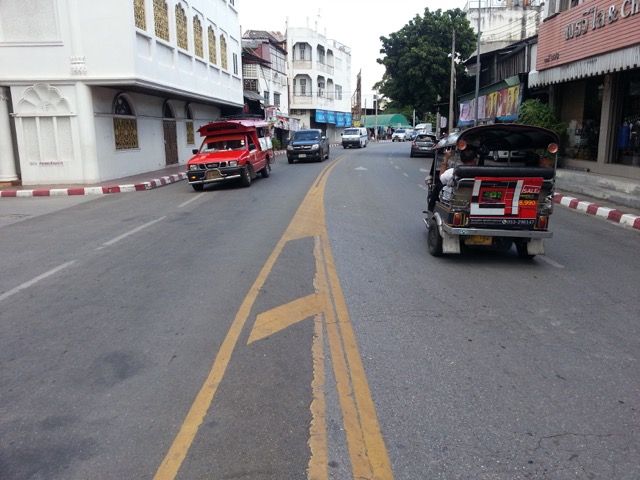
Reversal of left right traffic flows can lead to accidents because Thai people are not used to it.
This is at Chiang Moi Tud Mai road, near Warorot Market, where accidents can happen especially at night time when drivers don't pay attention to signs and follow 'normal' traffic flows.
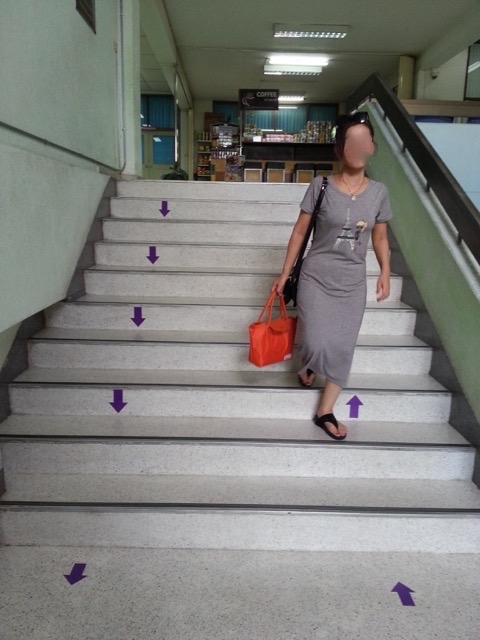
Thai people aren't used to unexpected traffic situations and so confusion can happen.
Ironically, this is at the Driving License Office (!) (officially Land & Transportation Office)
Another reversal of traffic flow failure of the Thai authorities is the marking of bicycle lanes against the traffic flow of some main roads. This was probably done to promote Chiang Mai as a "Bicycle City". The reality is that not many cyclists use these lanes, but instead motorcyclists often use it while they are not supposed to, and a lot of car drivers simply ignore the lanes which creates the chance of crashing into two-wheelers.
Accidents happen, and in Thailand accidents happen A LOT. In Chiang Mai only, I witness an average of 1-2 accidents on the road every month (!), meaning that I either see it happening right in front of me or I pass a place where an accident just happened minutes ago and the victims are still lying on the road. Besides that, I see near-accidents happening nearly every day, cars driving at centimeters aways from each other, and you can see the white chalk marks by the police nearly everywhere on the roads.
Dealing with injuries of traffic accidents is year-and-again in the top three of main activities in hospitals.
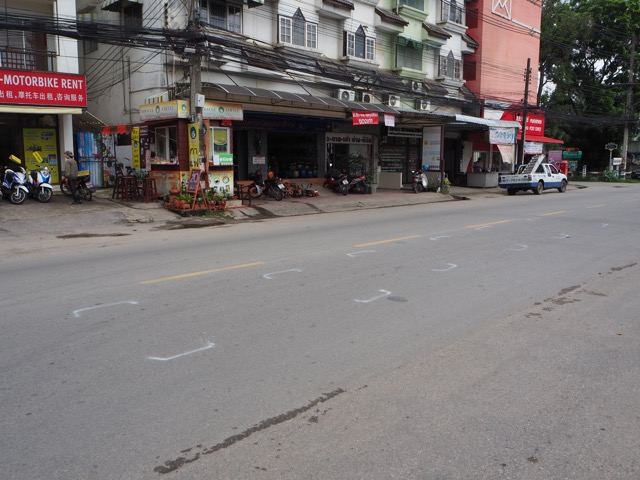
Police mark the positions of vehicles after a traffic accident. In this case, 6 cars were involved in a chain collision.
This suggests that the cars were driving too close too fast on an inner-city road.
Whatever your ambitions are, you don't want to leave your marks like this in Thailand.
It’s hard to get hold of official statistics, but a few common causes for accidents are:
In a recent article the BBC summarized the situation of death and accidents on Thailand's roads, confirming that it's due to a combination of lack of government action and enforcement and Thai people simply not following the rules.
POSSIBILITIES OF A TRAFFIC ACCIDENT
Here are some either typical traffic accidents that could happen in Thailand, or traffic accidents that you would not expect to happen:
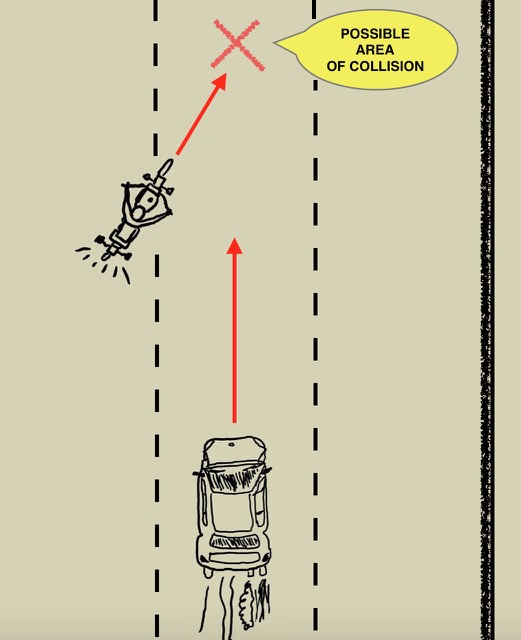
Possibilities for a traffic accident and differences in interpretation between Thai and international context:
the motorcycle driver changes lane without doing a proper mirror and shoulder check and collides with a fast driving car. In international traffic context, the motorcycle driver would probably have found to be wrong, but in Thai context it could well be that the car driver is (partially or wholy) blamed because he can see what's coming, he might have been driving to fast, and the motorcyclist is considered to be more vulnerable.
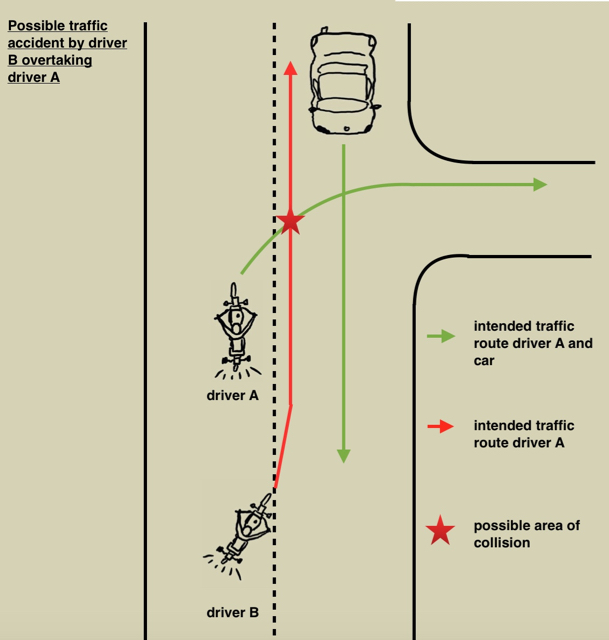
Driver A is waiting for the car from the opposite direction to pass before making a right turn into a soi. Driver B can't wait and crosses the middle line (sometimes even a double line) to over take driver A. At the moment that driver A wants to make the turn, driver B hits into driver A.
Driver B is wrong to overtake driver A when driver A is clearly signalling to be on the verge of making the turn.
Lesson: always check your mirrors and shoulder even in situations where you would not expect to need that.
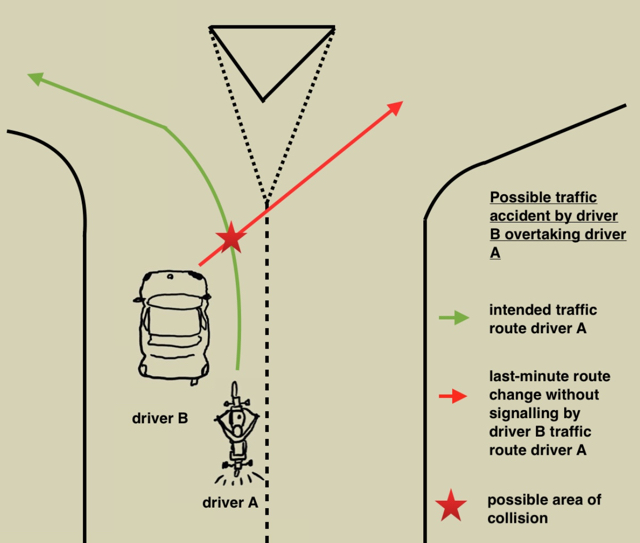
Driver B is in the left lane which leads to a left turn on a T-section, so driver A anticipates that driver B is making a left turn on the T-section just like him. However, driver B changes direction last-minute without signalling or by late signalling and collides with driver A. Driver B is wrong, but because driver B is still a littlebit in front of driver A, Thai interpretation might put some responsibility on driver A.
Lesson: antipicate how traffic behaves but also anticipate mistakes of others and put most of your attention in front of you.
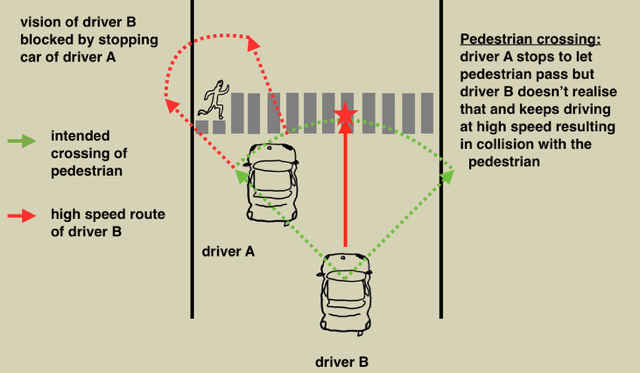
Driver A stops in front of a pedestrian crossing to let a pedestrian pass. Car driver B isn't alert enough to realize that driver stops for a pedestrian and keeps driving at high speed to collide into the pedestrian. The situation is even worse if the pedestrian is running to cross the busy road because then he appears very suddenly into the vision of driver B from behind car driver A.
Lesson: whenever someone stops on the road, realize there might be a reason and that you don't have full vision.
When you're the pedestrian, make sure that you are seen, don't run but move predictably.
This video by the Chiang Mai municipal government can give you some ideas of how traffic accidents happen in Thailand.
Source: Municipality of Chiang Mai
Being aware of the main Thai traffic "rules" I set out above and how they deviate from international traffic rule, you will be better equipped to stay safe.
Remember how much your value your life, your health and your time and realize that many Thai drivers may not value these things as much as you do.
When you engage in Thai traffic, be prepared to take on a double work load: think for yourself but also think for others around you. Not only do you have to look out in the normal way that you are educated to do, you also have to anticipate Thai drivers' mistakes. This is true not only for traffic, but also for all kinds of other situations, especially if you work with Thai people: you have to anticipate what could possibly go wrong.
While not neglecting your international driving rules' obligations to watch out 360 degrees around you, in Thai context mainly focus your attention in front of your vehicle. You need to put about 80-90% of all your attention in front of you within your Range of Responsibility. Correct international driving behaviour would put perhaps 60% of your attention in front of you and 40% of your attention around you, because this is also part of your responsibility. But in Thailand, you have to break with this habit because everyone else also does so and it's especially in front of you where accidents can happen suddenly all the time.
Don’t make sharp or sudden turns. When changing direction, signal and move gently. It's all about being seen and being predictable to your fellow road users so they can adapt to you.
In an international driving context, you are supposed to adjust your speed at the proper level: at times slower and faster where you can, you could even fail your exam by not driving fast enough. You're supposed to make smooth and fast turns.
In Thai context, this doesn't always work out well. Making a sudden quick turn or a sudden movement outside of your steady 'cruise-controlled' pace could surprise other road users who were anticipating your predictable behaviour.
For example, some in particular young Thai scooter drivers take over at very high speeds, zigzagging around other vehicles, often even without helmet. This irresponsible behaviour can only go unpunished when all other traffic is predictable. In such case, if you would make a sudden movement, however correct in international driving context, you become unpredictable to them, and a collision might happen. Even if it wouldn't be your fault, you don't want to get involved.
Another example is how some pedestrians, after having waited for a long queue of vehicles to pass, suddenly try to cross a road running when they see an opening in the never-ending traffic. They might be noticed by one vehicle but not by another vehicle which comes from another lane. Even when crossing a lane as a pedestrian, walk over in a composed, predictable manner making sure that all other traffic sees you, especially the second land you're crossing. Making a short sprint can only be safe when you are absolutely sure that there is no one left to hit you.
TO SEE AND TO BE SEEN
THAT IS THE QUESTION
IN STAYING SAFE IN THAI TRAFFIC
In the same way, don't stop to abrubtly. Try to stop slowly, so the traffic behind you can notice. Stopping in situations that the traffic behind you doesn't expect, for example if you want to exhibit gentleman behaviour for a pedestrian waiting to cross the road, can cause the driver behind you to hit you in the back.
Pay special attention when you know you're in someone's blind angle: quite often, cars suddenly make sideways moves and when the driver is too lazy to look around, you could be in his blind spot.
When you make sure you're seen (or even make eye contact), you may also sometimes notice that the rude anonymous behaviour shifts somewhat towards 'being krengjai'.
Do cars really stop at the zebra?
Anticipate how traffic, especially in front of you, will behave, rather than trusting that everybody follows the rules.
On many intersections, the lights turn green in a fixed sequence against the clock, but on some major intersections in Chiang Mai (Airport Plaza intersection, Rincome intersection, etc.), it's completely different, so don't anticipate the normal sequence and take off before the light turns green but actually watch.
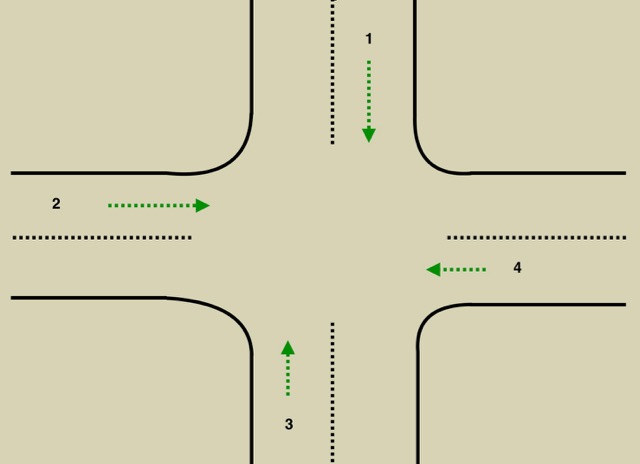
On many intersections, there is a fixed sequence in which lights turn green. However, this is not always the case. So don't take off before the light actually turns green, assuming the 'normal' sequence.
Generally, roads in Thailand are pretty good and comfortable to drive, main roads outside of the city can often be surprisingly good, so you can make great outings out of town. But in contrast, some parts of the roads inside the city can be pretty bad, with sudden and unexpected unevennesses or even holes in the roads. The lid of a sewage hole is suddenly much lower than the road surface, or the road has simply worn off with big holes and no one to take care of it. Especially when you're driving at high speed and expect a smooth road, hitting such a hole can bring you off your balance.
Some foreign drivers with lots of driving experience got killed in Thailand driving into caves in the road where they didn't expect it.
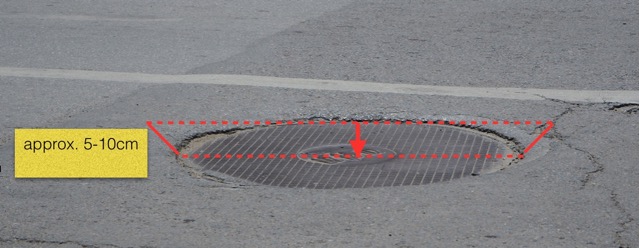
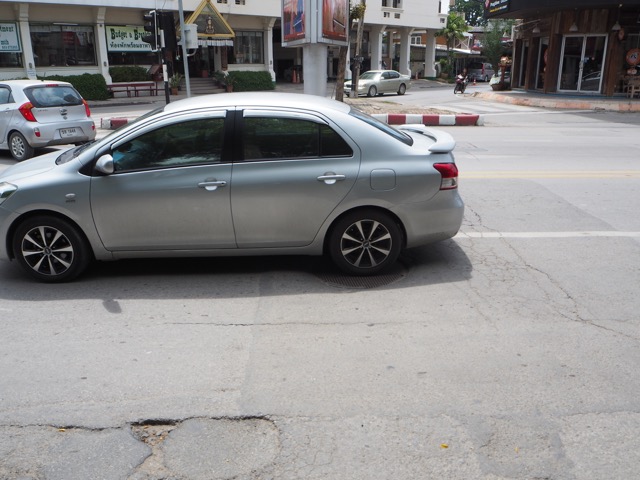
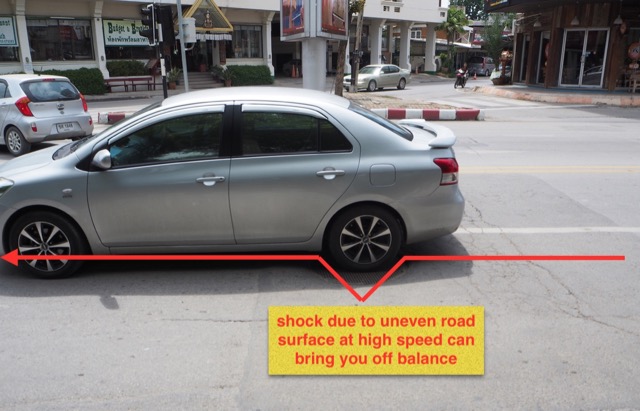
The water department didn't bother to put the lid of the water sewage system level with the road, in this case it's about 5-10cm deep compared to the road. It's practicably invisible and you won't expect it as you're focussing on the intersection, and it can have an impact on your stability when you're driving at high speed, especially on a motorcycle.
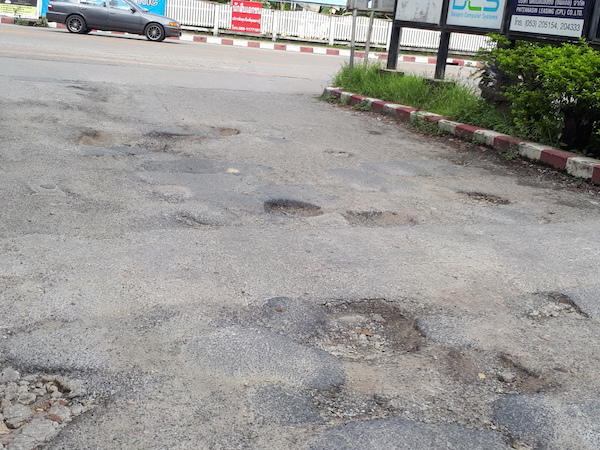
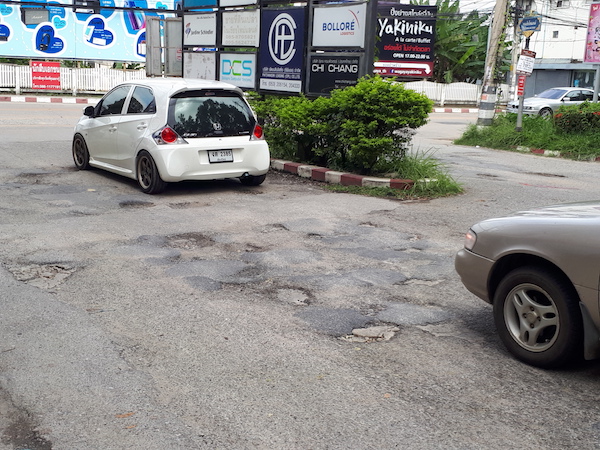
Holes in the road inside the city
In international driving, you should have learned to (1) signal first, then (2) do a shoulder check, then (3) change lane or make a turn. This is the correct way to change direction or make a turn, however, this doesn't go 100% well with Thai driving styles, so I recommend a different procedure:
(-1) watch first in mirror and shoulder check
(0) wait until the right moment to signal
(1) signal
(2) watch again in mirror and shoulder check
(3) make the turn or change lane.
Thai style driving context is different from international context in that you always have to be careful that no one is passing or overtaking you from the wrong side / angle. If you turn left, you not only have to check your right side (which is normal), but also your left side, because someone might just want to pass through going straight on your left.
Another difference is that you should not leave the signal on for too long. In international driving, you can leave the signal on for a while, traffic will notice and pass and you change lane or direction after you are able to do so.
In Thai context, this may not be the case. As soon as you signal, other drivers behind you are on alert as you are going to make a move which is within their Range of Responsibility. So you may find that the traffic behind you is waiting for you to change lane, whereas you're used to international traffic to simply pass.
So, don't signal too early. First check how much traffic is behind you. If you keep the signal for too long, you are 'disturbing' some road users behind you who are waiting for you to change lane or make a turn. If you keep it on for a very long time traffic behind you may think you have just forgotten that you left your signal on.
Signal, watch, and take action on your signal. Don't wait too long to take action on your signalling to others.
Within the city, don't drive faster than say 60-70 km/hour but adjust your speed all the time especiallly depending on how busy it is in front of you. Make sure you have maximum visibility and try to anticipate all kinds of traffic: pedestrians suddenly appearing from behind cars, scooters joining in the road without even bothering to look, road users in front of you who suddenly stop in the middle of the road 'for no reason' while you were just looking behind you, etc.
You need some margin in time to react, especially to adjust to other people's mistakes.
Roads in Thailand are generally good but there is more pollution including some petrol sedimentation on the surface of roads, which can become slippery especially when it rains. Also, some shops clean their own floors with soapy water and then throw the water on the road, which may make it slippery.
By leaning into the curve, you make yourself more fragile to loss of balance in case of slipping. Also, it's much harder to stop properly when you're in a leaned position in case you encounter another vehicle as your gravitational point is not straight above your tires, then stopping abrubtly will lead to slipping.
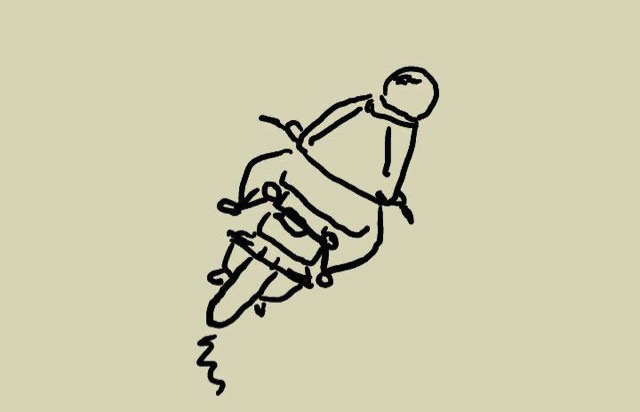
Leaning in curves can feel good, but roads are sometimes more slippery in Thailand
due to petrol and other dirt sedimentation on the surfaces. It's also much harder to stop abruptly in leaned position.
Thailand is a hot country during most of the year, so it's tempting to step on a scooter with flip-flops and hair blowing in the wind.
In accidents though, a helmet is the most crucial piece of protective clothing that can save lives and serious head injuries. The second most important is to have proper shoes.
Although almost standard in some other countries, gloves are often too much bother when you're just driving in the city. Besides that, long pants are actually better than short pants, not only as a protection against falling and scratching, but also against sun and mosquitos.
Besides that, nearly the only thing Thai police are actively enforcing is wearing a helmet. If you stay in Chiang Mai during about one month, chances that you pass a checkpoint checking on helmets are quite high (penalty officially about THB 400).
You can buy simple Thai quality helmets at a few hundred baht or very high quality ones at several thousands. Both will at least give you the most important basic level of protection.
If you drive a big bike and go around or out of the city at much higher speeds, all of this becomes much more serious and you should definitely at least wear proper shoes, gloves and helmet.
Most of the popular large banks in Thailand offer an accident insurance, in particular the one by Bangkok Bank is well-known amongst foreigners but other banks in fact provide nearly the same offer.
An accident insurance usually covers a substantial amount of damage in hospital bills (around THB 50,000) at a very modest price (about THB 1,000-2,000).
(The insurances are usually underwritten by an insurance company that the bank teams up with, so the bank just serves as a counter.)
Besides that, if you own a vehicle you should pay for your government license every year (just a few hundred baht) and when you do that, they will require you to have your vehicle inspected and get an obligatory accident insurance as well (just THB 100-200).
Perhaps the most important of all is: don't be over-confident. When you just start to drive a motorcycle or vehicle in Thailand, you may feel everything is under control, you're enjoying the roads or the landscape and you may become over-confident.
I had three minor slipping accidents in my time of driving here, and they all happened in the beginning because I felt too confident about driving and trusting the road or others.
Driving too fast, hanging in the curves, trusting the surface of the road, and trusting others to follow the rules can all come from over-confidence and will lead you into trouble.
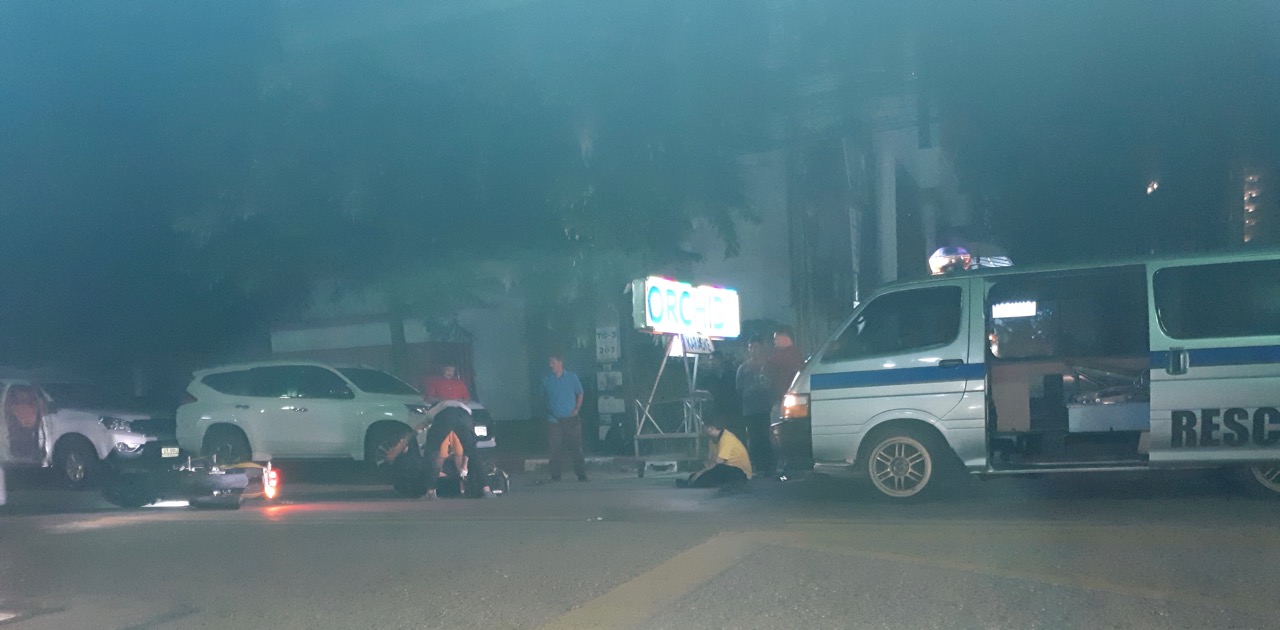
Living long-term in Chiang Mai, chances are you will witness a traffic accident or the minutes after an accident
To me, getting a Thai driving license is more of a legal necessity than that it will really help you to stay safe. Yes, you'll learn some things that the driving license office will test you on, but they won't teach how Thai people really behave on the arena of the road.
Passing a motorcycle or car driving license exam in a strict country and then applying this knowledge to the situation here has helped me to understand more about how Thai driving practise actually deviates from the international norms, and how to stay safe.
Don't forget, a Thai driving license cannot be converted to many 'stricter' countries, but vice versa it's possible.
Hopefully, these guidelines will help you to stay safer in Thai style driving. However, other dangerous situations occur with foreigners who pick up Thai-style driving habits and then take it to the extreme, which can be more dangerous than the 'predictable' Thai behaviour. Also, more and more Chinese tourists are appearing on the road, showing even more irresponsible driving, parking and studying maps in the middle of the road, etc. These drivers again have another driving style so they create yet other traffic situations which differ from Thai-style.
Kenny Wong for CM Locator
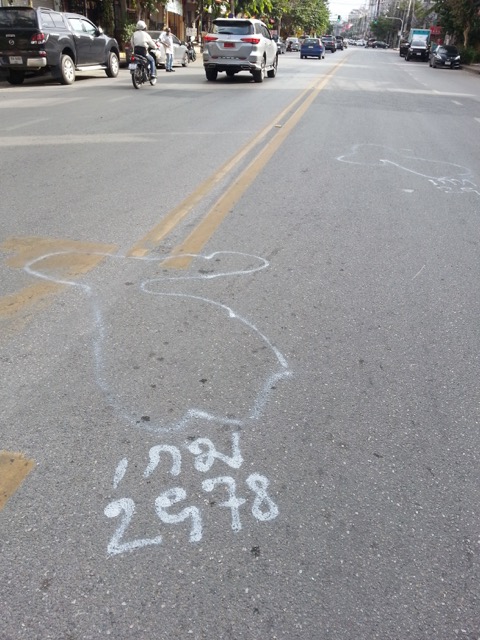
Not CSI (Crime Scene Investigation) but Traffic Accident Investigation: this is what happens after an accident.
Police marks the contours of your body and vehicle on the road, leaving these macabre white chalk marks as a painful reminder of a tragedy that happened in this very place.
Take care not to leave your marks on Chiang Mai in this way!
note 1: For the sake of style and simplicity, in this article I use generalisations such as 'T
Leave a comment
Note: By posting a comment or question, you will not automatically be notified when other people respond to your post (as in some other social media message threads). Please check the thread yourself if you’re interested in this topic.
| Jimbo Posted on April 12, 2024 at 09:41:34 I disagree with John's assertion that a random farang stopping to assist a traffic accident he or she didn't cause would be blamed or extorted for money. That's an old expat barstool tale and doesn't have any basis in reality except if the circumstances are such that someone could interpret the farang was involved, because he or she just narrowly avoided the accident or something. If however the farang clearly arrived after the accident occurred, it shouldn't be an issue but I'd still advise caution for different reasons as I'll explain below. I would avoid personally helping an accident victim who is seriously injured by doing CPR or something and then dies or gets worse, because that could then be blamed on you. Call a paramedic and let them handle it and absorb the responsibility, regardless of their level of competence or lack thereof. Moreover, as ridiculous as it sounds but in rare cases, the authorities could charge you for working without a work permit so don't be too helpful, unless it involves simply driving someone to a hospital or calling an ambulance and letting the "professionals" handle it. On the other hand, let's say you were out in the countryside and happened to witness a drunk driver who appears relatively unscathed and who simply needs to be taken to the hospital or police station and/or needs help getting his car out of a ditch. What do you do then? Call the authorities (assuming your Thai is up to scratch) and let them take care of it. I did so once, trying to make contact with police to help a drunk driver at 2am near Loei. Problem was nobody would pick up my calls or respond to my knocking on the police station because everyone was asleep! Finally, maybe around 3am and 50km from the scene by now, I managed to get a hold of emergency services and they said they'd respond to the call. In summary, circumstances will dictate how one responds to a situation but chances are, given how densely populated Thailand is, a local will never be too far away hence chances are, by the time you're there a bunch of locals will have arrived and they'll probably contact the authorities. Unless it's 2am in the dark near the Lao border like in the case I witnessed. | |
| Jimbo Posted on April 12, 2024 at 09:23:34 A pretty good write up, although a little negative and exaggerated in some respects. The article reads like it was written 25 years ago; things are certainly somewhat better now than they used to be, even if there's still a lot of work to be done. I disagree with your idea about why u-turns exist. Cultural reasons aren't why they were built, but poor urban planning. In greater Bangkok in particular, but to a lesser extent, the rest of the country as well, there is not nearly enough road space available for the amount of registered vehicles, there are few secondary roads and very few interconnecting roads that don't involve getting back on the main road. Traffic signaling systems are antiquated and usually manually controlled, along with an inability to acquire property to build new intersections and roads (thanks to superblocks), the u-turn functions as a method of allowing traffic to turn right. More and more traffic lights are being eliminated in favor of overpasses or interchanges, to permit a better flow of traffic. If they could eliminate all traffic lights in Bangkok, they would. Traffic lights are usually manually controlled or controlled with a simple countdown system that doesn't seem to take into account traffic flows. As a result, especially during rush hour, some directions may be stuck at a light that doesn't change to green for up to 45 minutes (though more typically wait times are no more than 5 minutes) but then green only lasts for 20 or 30 seconds and so only the first two rows of traffic can actually cross the intersection before the light goes red again. If Thai cities were better designed, this would involve the construction of hundreds if not thousands of bridges across the canals of greater Bangkok, then traffic would flow better too as motorists could use sois to navigate to their destination instead of the main roads they're currently forced to use. | |
| David Hutchinson Posted on April 01, 2024 at 12:47:58 Excellent article I would add - Always put the brain in gear before driving and always anticipate, do not rush. | |
| Bungalowbill Posted on April 01, 2024 at 07:07:59 Well put together, I have been riding big bike in cnx for 8 years, am cautious, have licence , safer on trips than cities, be carefull around market areas , as for local thais , food takes priority over common sense. | |
| Admin Posted on March 27, 2024 at 03:40:11 @Restless Soles: Bu(ffa)ll(o)sh*t. Then probably the same evil spirits won't disturb them when the roof leaks, the electricity falls out, the overall maintenance of the house lags several years behind and when they arrive home drunk to the skunk. It's called NEGLIGENCE, nothing else than that, except for in some small mountain village where your lady friend comes from. | |
| Restless Soles Posted on March 26, 2024 at 12:03:30 Good information. It clears up some questions about what drivers are doing and thinking that make sense. One thing that wasn't touched on is this: At night, you will see many motorbikes with no tail light or brake light on, and you usually don't see them until you are right up on them. I wondered if they never bother to replace the bulbs, or maybe they are expensive, so I asked a thai lady friend why so many don't have tail lights...she told me that "Thais are very superstitious, so they sometimes remove the bulb so that the evil spirits can not follow them home." After that, I try not to drive at night, if possible. | |
| Rogier Mulders Posted on March 11, 2024 at 08:45:25 Great reading! | |
| Grant Posted on December 23, 2023 at 03:01:17 Another tip, keep a loaded firearm or machete in your bum bag, sachet or in the boot of your car to assist in the mediation of any traffic disputes. | |
| Grant Posted on December 23, 2023 at 02:50:45 Tips to drive like the locals; 1. Drinking copious amounts of Lao Khao in the morning enhances your driving. Make sure you keep on drinking it through the day to further enhance your driving skills especially before dusk. 2. When you drive through a narrow village, don't slow down for anyone or anything especially if you are driving a lorry towing a trailor loaded up with sugar cane. 3. To be seen better, make sure your truck emits great amounts of black exhaust smoke. 4. You are a super star if you modify your truck with small diameter, wide tyres on the back, lower the suspension, put unessesary guages in the cabin and remove the rear bumper in favour of a stainless rod. | |
| Khunwilko Posted on December 14, 2023 at 13:53:28 Who is the author of this article? | |
| Henry Posted on October 04, 2023 at 06:28:45 Fantastic article, correct on so many points. I would suggest a bit more emphasis on the effect of range or responsibility how it effects us, the other driver. Example, the habit of pulling out from a side road onto a main road without looking to see if there is on coming traffic (as it requires looking to the side to see the oncoming traffic) I call this, "if I don't look, there will be no oncoming car." ไม่ดูไม่มี .. it happens so many times, it's a something to be very aware of. | |
| Michael Posted on September 18, 2023 at 14:19:29 Great and very tru information,…have been driving motorcycles and cars in Thailand for about 25 years. | |
| Motorcycle Paradise Posted on May 20, 2023 at 04:43:03 Excellent article. Should be read by anyone who plans on going to Thailand and renting a motorcycle. It might just save your life! | |
| Martin0 Posted on May 07, 2023 at 15:58:40 My Thai gf has a habit of leaving the main right, by turning right, like this.. Indicates right, then, regardless of oncoming traffic, proceeds to crawl to the minor road (whilst also cutting off traffic that may be coming from the minor road - ie turning too soon). It drives me crazy, because I'm sitting in the passenger seat and will be hit first by oncoming traffic :-( | |
| JohnB Posted on February 27, 2023 at 03:13:37 Excellent article, and essential reading for all drivers in Thailand IMO. I especially like the Range of Responsibility, which goes some way to explain my bewilderment at the poor drivers here. Some additional things I thought worth mentioning: • To me, the Land Traffic Act is less sophisticated - perhaps this word is inappropriate, 555 - than even the UK Highway Code of the nineteen-sixties, when I passed my motorcycle test. It's totally out-of-date, and unfit for purpose, in other words. • Poor road design: - 2-way U-turn design has visibility blocked by vehicls turning the other way. But they're re still included in new roads, often closed off one way shortly afterwards following accidents. - Almost no slip roads or filter lanes to join dual carriageway. - Tiny kerb radius at junctions means vehicles cannot turn without swinging out. • Poor 'junction etiquette' entering from a side street: - Stopping so far out as to block the inside lane: totally unnecessary, and inconsiderate. - Driving dangerously slowly when entering fast traffic. - Immediately entering the middle lane of three, and NEVER using an empty inside lane to adjust speed. - Sometimes going straight to the outside, fast lane, driving slowly despite no intention of turning right. • Blocking the outside, fast lane, making passing only possible on the inside (contrary to Section 45 of the Land Traffic Act). Many don't use their mirrors and are oblivious to what's behind them: the Range of Responsibility is applicable to car and commercial drivers too. • Some drivers are so immature that they'll refuse to let anyone pass, which can lead to very dangerous manoeuvres trying to pass. Finally, though I appreciate how controversial this may be, I've been advised on more than one occasion that foreigners should never stop to assist, or even offer to act as a witness, where they see a recent accident because there's a risk they will be blamed for causing it, and hence must pay compensation. Some less scrupulous Thais see it as an opportunity to exploit falangs, who 'can easily afford it' and whose usually poor language skills make them vulnerable. | |
| Suraj Posted on February 09, 2023 at 06:14:29 Three persons motorcycles allowed | |
| Siva Posted on January 29, 2023 at 08:16:08 One of the best article related to the understanding the roads, signals, traffic, driving and traveling habits followed in Chiang Mai. Thank you so much! Let me keep following! | |
| Frederic Posted on December 23, 2022 at 04:28:27 Best written piece ever written on the topic. Still accurate nowadays | |
| Steven Posted on November 09, 2022 at 06:15:29 My father taught me to drive over 50 years ago and I'll never forget the first thing he said to me: "Treat everyone else on the road as an idiot - and hope they think the same about you!" This philosophy works very well when driving here. | |
| Khunphil Posted on September 29, 2022 at 08:47:19 One of my pet hates is the amount of bikes, vechicles, trucks, buses that have broken tail/ stop lights or none at all ! | |
| Khunphil Posted on September 29, 2022 at 08:43:49 Very informative, although I have been safely riding bikes for years in nth Thailand, the article drums home the cautious common sense approach we have to maintain. Cheers. | |
| Chris Posted on October 07, 2021 at 12:32:57 Just started riding a scooter here (Phuket) and this article is extremely helpful! Thanks. | |
| Berns Posted on April 19, 2021 at 12:08:36 Very informative and accurate. I particularly like the Thai driver’s ‘Range of Responsibility’ explanation as that definitely clears up who must look out for who when in traffic in Thailand. The first rule when in Thai traffic is 'expect the unexpected'. One more bizarre traffic behaviour here in Thailand is when a rider/driver (from bicycles to vans) needs to make a U-turn that rider/driver stops on the left hand side of the road and then cut across traffic to make the U-turn. This behaviour is unsafe, unnecessary and completely selfish, but heck it is of course 'no problem' as long as you as seen by others, which is another rule of life in Thailand: as long as you are visible nothing else matters. | |
| Noah Paul Kanter Posted on April 04, 2021 at 05:53:57 Very good article. I learned all this very quickly since all I own is a motorbike. I am driving a Yamaha Aerox 155 because it has real rubber on the road. I never understood the scooters with pencil thin tires and three people on a bike. Scares me all the time. My experience with driving motorcycles since I was 14 (50 years now) and the Motorcycle Safety Foundation course teach defensive driving which helps a lot. | |
| Koen Posted on February 16, 2020 at 13:05:49 Driving daily in Thailand daily for over 20 years I'm very familiar with Thai traffic behavior. Your thoroughness (covering many scenarios) and especially the analyses impressed me. One frequently occurring scenario could be added to the list: motorcycles still signalling a turn/change of lanes that actually already happened some way back. | |
| John S Posted on January 08, 2020 at 13:39:02 Excellent article. I have been driving in Thailand for 20 years, and the advice given here is spot on. Once behind the tinted glass, personalities seem to change. Also, portable road hazard and disabled vehicle indicators don't seem to exist here. If you see tree twigs and leaves in the road, slow down! | |
| Dodger Posted on October 28, 2019 at 08:37:08 The article confirms everything that I have experienced. Well done. | |
| Hardcastle Posted on October 23, 2019 at 07:34:35 Excellent article. A driver u-turned from one carriageway onto mine and stopped across my lane. I'd already spotted him and slowed, but had nowhere to go, impacted and was ejected from the bike and over the top of his car landing on the road ahead. Police judged it to be his fault and tomorrow I have to go to the police station to meet with the driver. I think that this is to award me damages. Does anyone have experience of this and is it advisable to take along a personal injury lawyer to negotiate on my behalf? | |
| Stevo Posted on September 22, 2019 at 06:10:50 Pretty much spot on in your well explained post. Five years in this country, and though I’ve never had a accident in a car or motorbike, the number of near misses I’ve lost count of. It might be to the fact I spent many years as a long haul trucker and still have road awareness, though here, I’ve certainly had to go back to school... But yes, Thai people on the roads are incredibly selfish and arrogant, depending on what they are driving, for example, I see a big white or back Mercedes or BMW SUV with red Bangkok plates, chances are he will be very aggressive and arrogant to a greater extent than a local in his clapped out Nissan. But indeed, western concepts of driving and road rules will get you nowhere here, I tried to think like that for the first few months I was here on a hired motorbike, and soon found out it was useless, no one cared you put a indicator on, no one let you in, other cars and bikes would try and push you off the road to get that little bit ahead, so it was either adapt or step off, so I compromised.. I used some Thai techniques to move through and around in traffic whilst retaining my western common sense, so far it’s worked out. Plus knowing where and when to go doesn’t hurt, anyone can guess from around 3:30 on, everyone is going to rat race home, and after dark, going out on a bike is bloody dangerous, from cars or worse, young guys on their motorcycles, sometimes full of grog or yaba... I stopped trying to rationalise the Thai mentality on the whole, for us brought up in different civilisation, it takes a flexible mind to deal with such a different culture, I guess the best way to put it is, Mai b’pen rai... you’re never going to change anything here, the authorities have tried for years to change attitudes, but the people just carry on.. อะไรก็ตาม ... whatever... | |
| Eye4get56 Posted on August 24, 2019 at 01:24:12 Great post! These observations and tips should be formally presented in revised Motorcycle Driver Training and addressed in a NEW motorcycle specific written test. The same driver's exam is used for both cars and motorcycles, then they are very different. There is talk about a new "Big Bike" testing procedure (and tax of course) but nothing about revising testing for the over 20 million motorcycle drivers. Presently 70% of road traffic deaths involve motorcycle and the numbers are steadily on the rise. This is NOT a cultural issue. Education and Enforcement are essential to reversing this situation. | |
| Rodger Posted on March 20, 2019 at 07:00:43 You keep saying some but not all, sorry but they are the reckless and irresponsible as soon as they get on the road. Leave them to it, is what I say. They should not be allowed on the roads, and whats with the driving with no lights on at night? Silly, pure silly....... | |
| Andrew Posted on December 30, 2018 at 12:53:32 I think u missed out on the part where your traffic lights turn green, so does the opposite side too. They can turn into your road while u think u have the right of way. | |
| Uri Kimmelmann Posted on November 07, 2018 at 12:40:29 In my opinion this article should be handed over to the right personal in Thailand who are responsible for enforcing the traffic rules. They have to send to roads policemen in civil to imply and to collect fines in order to change dangerous habits. This action will deter all kind of drivers that misbehaved. | |
| Almer Posted on October 22, 2018 at 17:38:19 Confusion rains at round a bouts, clarification could easily be found with additional road markings or furniture signage | |
| Almer Posted on October 22, 2018 at 17:36:15 I understand your meaning kazy but i would cal it cant be bothered, a bit like a painter doing my house, when i asked why he wasnt putting primer on a new door the reply was that it would taje twice as long!!!! , i just think it is a pitiful state of affairs to see the young dead on the roads these bidies have investment in them and are the future, wiped out by ignorance, carelessness, or downright poor driving skills, i have read on many forums about the kack of a practical driving test and it shows on a regular basis | |
| Mike G Posted on September 05, 2018 at 09:34:46 Excellent clarity and puts my 2 years Thailand driving experiences into a very understandable context. Whilst I perhaps struggle a little with the concept that all Thais routinely become sociopaths when driving - as I have never experienced a country with LESS driver aggression - there is definitely a pronounced difference between Thais in everyday encounters and Thais in Travel mode. This article explains that mindset perfectly. Like most foreigners, I am here because I love both Thailand and its people - AND the smiles - but now I feel just that little bit safer, and more confident about tackling Bangkok traffic and surviving it !!! | |
| Maurice Posted on August 20, 2018 at 14:57:36 Outstanding article that is worthy to be published in one of the great guidebooks (Lonely Planet, etc.). But disturbing that so many people can't accept a generalization about Thai being lazy or not (of course not all are, that's why it's a generalization). The article is about traffic and Thai culture. To the author: write some more | |
| Gary W. Posted on August 18, 2018 at 05:15:17 After having worked, married and lived in Thailand for nearly 30 years I agree that most of the article is sensible advice and based on good observation. My recommendation for anyone intending to settle here and drive is to undertake a defensive driving course in your home country before you arrive. My Thai wife and I both did a Mercedes Benz defensive course in Australia and it set us up with the correct mental attitude and techniques to help us survive on the roads here and anywhere else. We use that training every day here. There is no room for ego on the roads anywhere and especially here. Most Thai drivers have no idea about skid control or braking distances and the consequences of speed. There are some generally good habits practiced as well. A vehicle in the left lane behind a slower vehicle will apply his brakes lightly to allow you to overtake in the right lane. That is a signal that he does not intend to pull out in front of you. A good idea that I use now too. Thai drivers are shown how to operate the vehicle not taught proper traffic driving techniques or to anticipate events ahead of their car. I would not denigrate Thais by calling them lazy at all but they do like to take short cuts when they think they can do it. You need to be aware of that probability. It pains me to see people whom I like very much being killed and injured pointlessly when more training would be of great benefit. Also car and pickup TV commercials emphasize speed and maneuverability over safety when appealing to young drivers. This should change. Treat every driver on the road as someone who is trying to kill you and drive accordingly. | |
| Arthur Posted on August 08, 2018 at 10:38:22 I'm Thai and I've lived in Europe. What this author writes about Thai traffic and how it is related to Thai culture is very true. I have not read an article about actual Thai behaviour and culture that shows such deep understanding. I do not mind that the author refers to some features of Thai culture as being lazy, it is actually true for many Thai. @Mike Postlethwaite: What I do mind is that so many politically correct people from the West have come to Thailand and think they know all about morals. Especially the neo-anti-racists who are afraid to see a reality and name it. | |
| Mike Postlethwaite Posted on July 22, 2018 at 17:46:17 an excellent article with many interesting cultural references tainted by overly broad negative racial comments and stereotypes ...to any thai people reading this article I would like to say that the vast majority of westerners do not think all thais are lazy and stupid and in spite of the writers deep knowledge of this subject he is extremely unbalanced in this area | |
| Tony Posted on April 05, 2018 at 11:36:19 The best article on driving in Thailand I have read. An outstanding piece of writing based on the actual facts and not just whining about how westerners think it should be. Thank you for sharing. | |
| Matthew J. Posted on March 19, 2018 at 06:29:37 Wow, such an in-depth and truthful article. The author really has deep understanding about Thai culture. I've been here for 12 years and agree about everything that he says. Never mind visitors to Thailand who travelled to Thailand 45 times, they still have that rosy picture in their mind and don't compare with people who really stay for years. Laziness is a part of most of Thai culture, it's even considered a virtue. That's not a judgement, it's just something to accept and work with. Thai products are not doing well around the world. And tourists come here because it's such a laid back place. Anyway, the article is not about that, it's about how Thai traffic is different from international traffic and how you can stay safe and I think every newcomer should read it. | |
| bosse Posted on March 10, 2018 at 09:46:04 I have been living in Thailand for 30 years, and I agree with EVERYTHING said in the article; it is exactly how things are. Of course, there are exceptions, as always, but it describes the Thai mindset correctly. Especially "cutting corners", which one can experience in most everything.. Let me give just one example, though not related to traffic: One year or so, after a funeral, there should be a "memorial". (Which I think is a good idea), but many hold the memorial directly after the funeral.... | |
| Kohn Yi Posted on February 28, 2018 at 22:06:01 Thai people are not inherently lazy. Has the writer ever been to a rice farm, a wood carving village, a factory, a bank, a school, or a restaurant? Why is Thailand products doing so well around the world. Why does Thailand export most of the worlds tapioca? Is tourism so big there because Thai's dont work hard to make it nice for visitors at a very low cost? The writer says that Thailand should not be called "land of smiles". I have been going there on off for 45 yrs and "he" couldnt be more wrong. Just check any travel logs from tourist after they vacation there. They all the same thing...how nice the people are. I dont think the writer has ever been to LA where I grew up. He would really know what lazy people are, what rude people are and just how unstable traffic rules are in an area with millions of over privileged, rude, spiteful, and unhappy group of people. Or visit Atlanta, where I worked for a time, or Memphis (absolute worst) or DC where I lived as a kid, or Dallas where I live close to now. People drive like shit there. And talk about rude and unhappy! I have driven all over Asia including Manila and all over Korea. They suck at driving too. And you havent seen lazy untill youve been to the PI. You havent seen people that dont smile (still nice people though) (if you went through the Korean war you wouldnt smile either) unit youve been to Korea.... Driving is a challenge for sure and there are many accidents. I ve been in my share. But dont place the blame on the shoulders of the Thai culture. They are relatively new to being industrialized and having so many vehicles. For yrs bikes were the corner stone of transportation there. Traffic laws and roads were only modernized within the last 25 yrs. America has been working at it for over 100 yrs. In 1972 there were 2 traffic lights in Ubon. Korat probably had less than 10. Thais are busy people and work hard and this creates a lot of shortcuts (as the author correctly pointed out) that are not often seen in other places...but then have you ever been to the country side of the PI, or Arkansas, or anywhere in central/south America? I have driven in Northern Mexico many times and even in the small towns and country side you are taking your life in your hands and you may see at least one accident a day there without seeing many cars. And when you violate the law (or wrongly accused of it) you best be prepared to pay up of go to a shit hole of a jail without due rights in most cases. You will probably treated like shit by the police and they will believe anything a local says above anything you can prove with good evidence or common sense. So dont go to Thailand...dont drive there, dont leave your hotel, or travel. Dont talk or visit with the most friendly people in the world. If you do you may discover the writer is probably right about the poor traffic and driving conditions but "his" assessment of the Thai people is so off base and in poor taste that it reflects poorly on the whole article and him as well. Sorry for the diatribe. I have too much time on my hands. | |
| Jackie Posted on February 28, 2018 at 14:19:49 Traffic rules are disobeyed in Thailand 24/7 12/365 ... this is why Thailand has the second highest number of road fatalities per capita in the WORLD!!! | |
| BKK_James Posted on February 20, 2018 at 08:42:35 Fascinating article. For those people who plan to ride motorcycles/drive in Thailand, I suggest that they watch the video below. Might get them to think twice... https://www.youtube.com/watch?v=uMaxh9-u3v4 | |
| Bunny Gee Posted on February 13, 2018 at 17:03:38 Superbly written article. You have both my congratulations and my thanks. Am I the only person though who, when considering the first drawing in article 4, thinks perhaps the Thai way is actually more safe and sensible in that the green "correct" lines afford two opportunities for a collision. whereas the red "incorrect" lines offer none? Just a thought. | |
| Dazza Posted on January 22, 2018 at 10:20:00 A must read for anyone coming to Thailand......even better to read when you've been driving for a couple of days.....explains it all. | |
| bobo Posted on January 20, 2018 at 19:09:12 BullSniffer: maybe he is. but he is extremely accurate in this writing. is there anything in this article that is incorrect? please inform. thx. | |
| BullSniffer Posted on January 19, 2018 at 13:42:31 The author is a biggoted moron. |
©2025 chiangmailocator.com. All rights reserved. Powered by annuaire SEO.